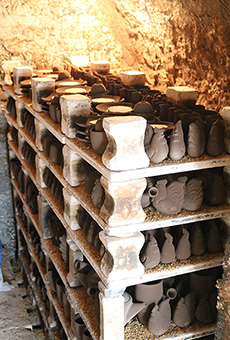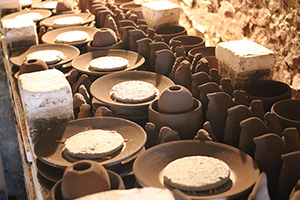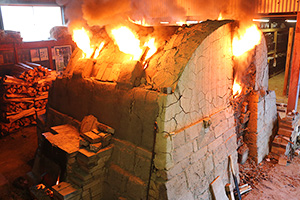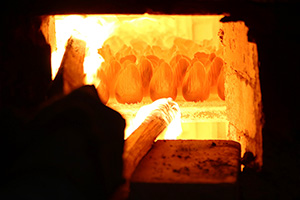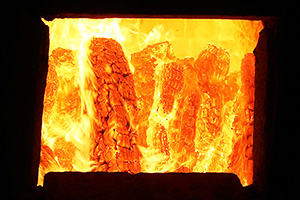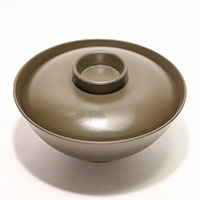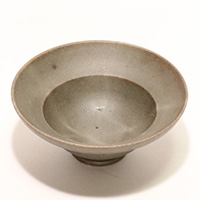The history of Bizen Ware
Bizen Ware which has long history developed while being descended from a Sue Ware and kept being burned during about 1000 years in Inbe of Bizen city as one of Six Old Kilns of Japan.
From the last years of Heian period to the early years of Kamakura period, Bizen Ware was equipped with its feature, and Bizen Ware adapted oneself to the fashion of Wabi-cha excellently in Muromachi period. Plain value of Bizen Ware because of glaze-lessness was liked as tea bowl in Momoyama period because it value led to the field of 「Wabi」「Sabi」. Senno Rikyu liked Bizen Ware and Oda Nobunaga and Toyotomi Hideyoshi who Rikyu served liked Bizen Ware too. In particular, Hideyoshi used Bizen Ware at every time he held big tea ceremony and he used Bizen Ware for his coffin too. In this way, Bizen Ware was being known to the whole country with prosperity of Wabi-cha.
In Edo period, feudal lord of Okayama-Ikeda Mitsumasa made a system of an officially potter of Bizen Ware and appointed Six Oldest Bizen Ware Potteries (Kaneshige,Kimura,Mori,Ooae,Terami,Tonguu) to preserve Bizen Ware. Because of this, small-scale kilns were integrated and large-scale shared kilns were made in south, north, west, so a manufacturing organization by Six Oldest Bizen Ware Potteries was complete. This officially potter is a master potter of Bizen Ware appointed by a feudal domain of Okayama and they concentrated on production of gift for the Shogun and Daimyos, so produced many masterpieces.
After that, production of Bizen Ware declined gradually because production of porcelain became popular in Kyoto, Arita, Seto. From Meiji period to the early years of Showa period, it was the worst time of Bizen Ware but kilns kept being burned and various efforts were continued.
In this situation, Kaneshige Touyou became a living national treasure in A.D.1956 so many people made a lot of efforts and the worst time of Bizen Ware has ended. Popularity of Bizen Ware also rose at foreign countries from these days and Fuziwara Kei, Yamamoto Toushuu, Fuziwara Yuu, Isezaki Jun became a living national treasure.
And now, we inherit tradition and we challenge new styles, so Bizen Ware keeps being produced even now in this city.
The feature of Bizen Ware / The design of Bizen Ware
Bizen Ware's greatest feature is beauty of the design by the glaze-lessness. Each one of Bizen Ware is made of good clay, and desiccated, and burned without using glaze. So the design produced by clay and flame has various many varieties for example Goma, Sangiri, Hidasuki etc… , and it is the only one and kaleidoscopic one, and it have the deep aim and the taste of 「Wabi」「Sabi」. Because of glaze-lessness design, gloss of Bizen Ware increases and come to feel smooth by using it for a long time.
It's said that Bizen Ware doesn't break even if it's thrown, this tells hardness and solidness by Bizen Ware's being burned during more than one week in about 1000℃ flame. Any other, it's said that the water in the Bizen Ware isn't sour because the state of the living water is kept by Bizen Ware's many minute stoma and a little air permeability. Therefore, it's said that a flower in a vase of Bizen Ware lasts long, and liquor becomes fragrant and mellow and rich taste. And its surface which shows the feel of material of the clay because of graze-lessness has high foaming ability because of minute unevenness, so it's said that the fine bubble up when pouring beer and you can drink beer well without missing the fragrance. And it's said that Bizen Ware has the ultra-red ray effect.
The clay
The clay of Bizen Ware is old soil in Inbe which included iron much, and it's made by mixing rice paddy's soil and mountain's soil. Lifted soil is left in outside, be dried, be crushed, be soaked in water, be melted, be settled, be filtered, and moisture is squeezed. The clay is becoming good by the working of the microorganism during long maturity so it mature for several years while being kneaded many time.
How to make form
The clay of Bizen Ware is kneaded carefully before making form to deflate in the clay tightly. This is to prevent a work breaking by swelling shut air when it's burned, and this is called Kiku-neri.
The ring-stacking method
It is the method that, the foundation which becomes the bottom of work is made, stack ring of clay up one by one, stack up highly while arranging the shape.
The potter's wheel method
It is the method forming a work as one thinks by touching clay though rotating a potter's wheel.
The forming by hand method
It is the method forming by hand while kneading clay without using potter's wheel.
The casting method
It is the method forming by pouring the clay melted muddily into the plaster mold. This method is used mainly when making an ornament.
The drying
The formed work is crammed into a kiln after it's made drying in the shade and it's made drying naturally during about 10 days.
The being crammed works into a kiln
Bizen Ware's greatest feature is beauty of the glaze-lessness design by flame, so the work crammed into a kiln while imagining the finish of the design is very important. A potter forcasts how to flow a flame in the kiln by experience and thinks where to arrange a work. The design changes with various factors for example how to touch a flame, how to hang ash, arrangement of a work etc… so there are many cases it won't be as expected, but that is value of Bizen Ware.
The burning works in a kiln
Most of a kiln of Bizen Ware is a climbing kiln, and keep burning a kiln for more than one week by making split firewood of pine fuel. There is necessity which raises the temperature slowly while extracting moisture so keep burning a kiln for a long time. Bizen Ware shrinks hard by burning so it breaks when the temperature in a kiln is raised suddenly. Bizen Ware becomes hard and solid because of being burned in about 1000℃ flame. In the middle of burning a kiln, a potter hangs ash on works to change the design.
The being taken works out from a kiln
The inside is hot just after burning a kiln so when a door will be opened immediately, the temperature falls suddenly, and works breaks. Therefore a kiln is cooled slowly during about one week, and works are taken out from a kiln after that.
The finishing
Bizen Ware has finished burning hanged ash on, straw was wound around, and was covered split firewood and dust. Therefore works taken out are polished beautifully by using a file and cloth. A potter checks whether works aren't broken and damaged, and checks whether there isn't water leaking in a bowl and a vase.
The variety of design
Goma
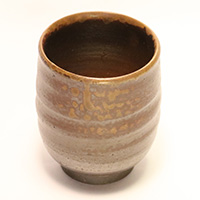
The design like as sesame was sprinkled by ash which stuck in a work melts hotly and becoming glaze.
Sangiri
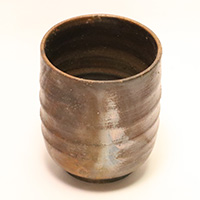
The design with the various changes by being smoked because a work is buried in ash and air flows becomes bad. It becomes gray, black, blue, and the glossy color like the metal. The method to make Sangiri artificially is also used in the modern times by using a chemical action of charcoal that a lot of charcoal is thrown just before stopping to burn a kiln.
Hidasuki
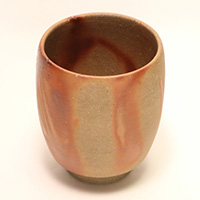
The design with scarlet lines by an ingredient's of straw and iron's of clay causing a chemical reaction because straw is wound around a work and it's burned.
Blue Bizen
The gray and blue design by being smoked hard because it was put at the spot where almost no oxygen.
Lacquer ware of Bizen
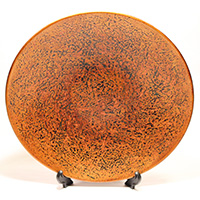
Fused work of Bizen Ware and lacquer ware which lacquered the surface of Bizen Ware. It was produced for a period to make a new attempt in Bizen Ware.
The using method of Bisen Ware
Before use
Filling
The feature of Bizen Ware is that the texture of the clay remains and the warmth can be felt, but the water absorption is high so it's easy to adsorb dirt and stain.
Such dirt and stain are changing to the texture for a long time using, but it's better to do filling before use.
At the time of use
Steeping in water
It's possible to stop adhesion of oil and smell by steeping it in water for a long time before dishing up. Please use it after steeping it in water and wiping up moisture.
Use of microwave
Use of microwave is almost no problem.
Use of an oven・Open fire
Please don't do an open fire and don't use an oven.
After use
Washing
It's better to wash as soon as possible after use.
It's possible to use a neutral detergent.
Use of dishwashing machine
It's possible to use dishwashing machine but please set it not to hit each other.
Keeping
Please put it after it's dried sufficiently after washing. Mold and smell may occur when you put it without being dried sufficiently.
These using method is a general point to notice.
It isn't also unusual that the using method changes with a pottery and a potter.
It's better to ask the store where you bought Bizen Ware about using method.

